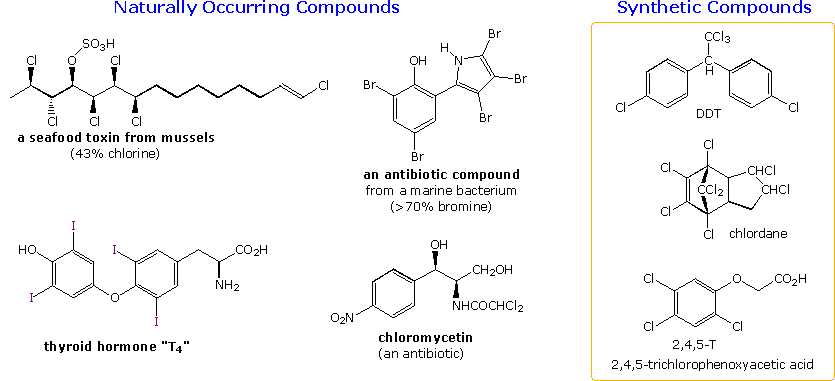


 علم الكيمياء
علم الكيمياء 
 الكيمياء التحليلية
الكيمياء التحليلية 
 الكيمياء الحياتية
الكيمياء الحياتية 
 الكيمياء العضوية
الكيمياء العضوية 
 الكيمياء الفيزيائية
الكيمياء الفيزيائية
 الكيمياء اللاعضوية
الكيمياء اللاعضوية 
 مواضيع اخرى في الكيمياء
مواضيع اخرى في الكيمياء
 الكيمياء الصناعية
الكيمياء الصناعية |
Read More
Date: 2-10-2018
Date: 29-7-2018
Date: 21-10-2019
|
Halogen containing organic compounds are relatively rare in terrestrial plants and animals. The thyroid hormones T3 and T4 are exceptions; as is fluoroacetate, the toxic agent in the South African shrub Dichapetalum cymosum, known as "gifblaar". However, the halogen rich environment of the ocean has produced many interesting natural products incorporating large amounts of halogen. Some examples are shown below.
The ocean is the largest known source for atmospheric methyl bromide and methyl iodide. Furthermore, the ocean is also estimated to supply 10-20% of atmospheric methyl chloride, with other significant contributions coming from biomass burning, salt marshes and wood-rotting fungi. Many subsequent chemical and biological processes produce poly-halogenated methanes.

Synthetic organic halogen compounds are readily available by direct halogenation of hydrocarbons and by addition reactions to alkenes and alkynes. Many of these have proven useful as intermediates in traditional synthetic processes. Some halogen compounds, shown in the box. have been used as pesticides, but their persistence in the environment, once applied, has led to restrictions, including banning, of their use in developed countries. Because DDT is a cheap and effective mosquito control agent, underdeveloped countries in Africa and Latin America have experienced a dramatic increase in malaria deaths following its removal, and arguments are made for returning it to limited use. 2,4,5-T and 2,4-D are common herbicides that are sold by most garden stores. Other organic halogen compounds that have been implicated in environmental damage include the polychloro- and polybromo-biphenyls (PCBs and PBBs), used as heat transfer fluids and fire retardants; and freons (e.g. CCl2F2 and other chlorofluorocarbons) used as refrigeration gases and fire extinguishing agents.



|
|
|
|
دخلت غرفة فنسيت ماذا تريد من داخلها.. خبير يفسر الحالة
|
|
|
|
|
|
|
ثورة طبية.. ابتكار أصغر جهاز لتنظيم ضربات القلب في العالم
|
|
|
|
|
|
|
العتبة العباسية المقدسة تقدم دعوة إلى كلية مزايا الجامعة للمشاركة في حفل التخرج المركزي الخامس
|
|
|